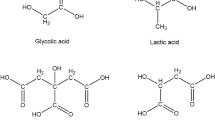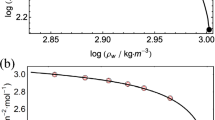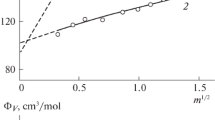Abstract
Solvent-corrected reduced isotropic Raman spectra of aqueous potassium bisulfate solutions in light and heavy water have been obtained from perpendicular and parallel polarization measurements in sealed quartz tubes over the temperature range 25 to 200 °C at steam saturation pressure, using the perchlorate anion, \({\text{ClO}}_{4}^{ - }\), as an external standard. The deconvoluted peak areas were used to determine the relative concentrations of hydrogen/deuterium sulfate ion to sulfate, \({{m_{{{\text{HSO}}_{4}^{ - } }} } \mathord{ {\vphantom {{m_{{{\text{HSO}}_{4}^{ - } }} } {m_{{{\text{SO}}_{4}^{ - } }} }}} }/ {m_{{{\text{SO}}_{4}^{ - } }} }}\) and \({{m_{{{\text{DSO}}_{4}^{ - } }} } \mathord{ {\vphantom {{m_{{{\text{DSO}}_{4}^{ - } }} } {m_{{{\text{SO}}_{4}^{ - } }} }}} } /{m_{{{\text{SO}}_{4}^{ - } }} }}\), from which the second ionization constants of sulfuric acid, K2,m,H for the reactions \({\text{HSO}}_{4}^{ - }\) ⇌ H+ + \({\text{SO}}_{4}^{2 - }\) and \({\text{DSO}}_{4}^{ - }\) ⇌ D+ + \({\text{SO}}_{4}^{2 - }\) were calculated. Results for the ionization constant in light water agree with the literature values to within ± 0.034 pK units at all temperatures under study, confirming the reliability of the method. Values for the second ionization constant of deuterated bisulfate, and the deuterium isotope effect, \(\mathrm{\Delta p}{K}_{2,m,\mathrm{H}}=\mathrm{p}{K}_{2,m,{\mathrm{ D}}}-\mathrm{p}{K}_{2,m,{\mathrm{ H}}}\) differed significantly from previous literature results at elevated temperatures. This results in an almost constant value of \(\mathrm{\Delta p}{K}_{2,m,\mathrm{H}}\)≈ 0.425 ± 0.076 over the temperature range under study. Differences in \(\mathrm{\Delta p}{K}_{2,m,\mathrm{H}}\) values between the literature and current results can be attributed to the effect of dissolved silica from cell components. The new results are consistent with computational estimates by density functional theory, and classical models that treat the temperature dependence of \(\mathrm{\Delta p}K\) by considering differences in the zero-point energy of hydrogen bonds in the hydrated product and reactant species.






Similar content being viewed by others
References
Laughton, P.M., Robertson, R.E.: Solvent isotope effect for equilibria and reactions. In: Coetzee, J.F., Ritchie, C.D. (eds.) Solute-Solvent Interactions, p. 125. Marcel Dekker Inc, New York (1969)
Shoesmith, D.W., Lee, W.: Ionization constant of heavy water (D2O) in temperature range 298 to 523 K. Can. J. Chem. 54(22), 3553–3558 (1976)
Mesmer, R.E., Herting, D.L.: Thermodynamics of ionization of D2O and D2PO4–. J. Solution Chem. 7(12), 901–913 (1978)
Lietzke, M.H., Stoughton, R.W.: Second dissociation constant of deuteriosulfuric acid from 25 to 225 °C. J. Phys. Chem. 67(3), 652–654 (1963)
Lietzke, M.H., Young, T.F., Stoughton, R.W.: Bisulfate acid constant from 25 to 225 °C as computed from solubility data. J. Phys. Chem. 65(12), 2247–2249 (1961)
Bulemela, E., Tremaine, P.R.: D2O Isotope effects on the ionization of β-naphthol and boric acid at temperatures from 225 to 300 °C Using UV-VIsible spectroscopy. J. Solution Chem. 38(7), 805–826 (2009)
Erickson, K.M., Arcis, H., Raffa, D., Zimmerman, G.H., Traemaine, P.R.: Deuterium isotope effects on the ionization constant of acetic acid in H2O and D2O by AC conductance from 368 to 548 K at 20 MPa. J. Phys. Chem. B 115(12), 3038–3051 (2011)
Erickson, K.M., Arcis, H., Raffa, D., Zimmerman, G.H., Traemaine, P.R.: Correction to “Deuterium isotope effects on the ionization constant of acetic acid in H2O and D2O by AC conductance from 368 to 548 K at 20 MPa.” J. Phys. Chem. B 123(44), 9503–9506 (2019)
Conrad, J., Sasidharanpillai, S., Tremaine, P.R.: Second dissociation constant of carbonic acid in H2O and D2O from 150 to 325 °C at p = 21 MPa using Raman spectroscopy and a sapphire-windowed flow cell. J. Phys. Chem. B 124(13), 2600–2617 (2020)
Conrad, J., Tremaine, P.R.: Third dissociation constant of phosphoric acid in H2O and D2O from 75 to 300 °C at p = 20.4 MPa using Raman spectroscopy and a titanium-sapphire flow cell. PCCP 23(17), 10670–10685 (2021)
Dickson, A.G., Wesolowski, D.J., Palmer, D.A., Mesmer, R.E.: Dissociation constant of bisulfate ion in aqueous sodium chloride solutions to 250 C. J. Phys. Chem. 94(20), 7978–7985 (1990)
Hnedkovsky, L., Wood, R.H., Balashov, V.N.: Electrical conductances of aqueous Na2SO4, H2SO4, and their mixtures: limiting equivalent ion conductances, dissociation constants, and speciation to 673 K and 28 MPa. J. Phys. Chem. B 109(18), 9034–9046 (2005)
Lietzke, M.H., Stoughton, R.W.: The solubility of silver sulfate in sulfuric acid media at high temperatures. Effects on the silver, silver sulfate electrode. J. Am. Chem. Soc. 78(13), 3023–3025 (1956)
Marshall, W.L., Jones, E.V.: Second dissociation constant of sulfuric acid from 25 to 350 °C evaluated from solubilities of calcium sulfate in sulfuric acid solutions. J. Phys. Chem. 70(12), 4028–4040 (1966)
Dawson, B.S.W., Irish, D.E., Toogood, G.E.: Vibrational spectral studies of solutions at elevated temperatures and pressures. 8. A Raman spectral study of ammonium hydrogen sulfate solutions and the hydrogen sulfate–sulfate equilibrium. J. Phys. Chem. 90(2), 334–341 (1986)
Rudolph, W.: Structure and dissociation of the hydrogen sulphate ion in aqueous solution over a broad temperature range: A Raman study. Z. Phys. Chem. 194, 73–95 (1996)
Knopf, D.A., Luo, B.P., Krieger, U.K., Koop, T.: Thermodynamic dissociation constant of the bisulfate ion from Raman and ion interaction modeling studies of aqueous sulfuric acid at low temperatures. J. Phys. Chem. A. 107(21), 4322–4332 (2003)
Applegarth, L.M.S.G.A., Pye, C.C., Cox, J.S., Tremaine, P.R.: Raman spectroscopic and ab initio investigation of aqueous boric acid, borate, and polyborate speciation from 25 to 80 °C. Ind. Eng. Chem. Res. 56(47), 13983–13996 (2017)
Sasidharanpillai, S., Arcis, H., Trevami, L., Tremaine, P.R.: Triborate formation constants and polyborate speciation under hydrothermal conditions by Raman spectroscopy using a titanium/sapphire flow cell. J. Phys. Chem. B. 123, 5147–5159 (2019)
Brooker, M.H., Tremaine, P.R.: Raman studies of hydration of hydroxy complexes and the effect on standard partial molar heat capacities. Geochim. Cosmochim. Acta 56(6), 2573–2577 (1992)
Brooker, M.H., Hancock, G.T., Rice, B.C., Shapter, J.: Raman frequency and intensity studies of liquid H2O, H218O and D2O. J. Raman Spectrosc. 20(10), 683–694 (1989)
Fernandez, D.P.: A formulation for the static permittivity of water and steam at temperatures from 238 K to 873 K at pressures up to 1200 MPa, including derivatives and Debye Hückel coefficients. J. Phys. Chem. Ref. Data 26(4), 1125–1166 (1997)
Uematsu, M., Frank, E.U.: Static dielectric constant of water and steam. J. Phys. Chem. Ref. Data 9(4), 1291–1306 (1980)
Trevani, L.N., Balodis, E.C., Tremaine, P.R.: Apparent and standard partial molar volumes of NaCl, NaOH, and HCl in water and heavy water at T = 523 K and 573 K at p = 14 MPa. J. Phys. Chem. B 111(8), 2015–2024 (2007)
Okada, K., Yao, M., Hiejima, Y., Kohno, H., Kajihara, Y.: Dielectric relaxation of water and heavy water in the whole fluid phase. J. Chem. Phys. 110(6), 3026–3036 (1999)
Noyes, A.A.: The Electrical Conductivity of Aqueous Solutions. Carnegie Institution of Washington, Publication No. 63, Part VIII., Washington, D.C. (1907)
Anderson, G.M., Castet, S., Schott, J., Mesmer, R.E.: The density model for estimation of thermodynamic parameters of reactions at high temperatures and pressures. Geochim. Cosmochim. Acta. 55(7), 1769–1779 (1991)
Wagner, W., Pruß, A.: The IAPWS formulation 1995 for the thermodynamic properties of ordinary water substance for general and scientific use. J. Phys. Chem. Ref. Data 31(2), 387–535 (2002)
Hill, P.G., MacMillan, R.D.C., Lee, V.: A fundamental equation of state for heavy water. J. Phys. Chem. Ref. Data 11(1), 1–14 (1982)
Nakahara, M., Matubayasi, N., Wakai, C., Tsujino, Y.: Structure and dynamics of water: from ambient to supercritical. J. Mol. Liq. 90(1), 75–83 (2001)
Mesmer, R.E., Marshall, W.L., Palmer, D.A., Simonson, J.M., Holmes, H.F.: Thermodynamics of aqueous association and ionization reactions at high temperatures and pressures. J. Solution Chem. 17(8), 699–718 (1988)
Seward, T.M., Driesner, T.: Chapter 5: hydrothermal solution structure: experiments and computer simulations. In: Palmer, D.A., Fernández-Prini, R., Harvey, A.H. (eds.) Aqueous Systems at Elevated Temperatures and Pressures, pp. 149–182. Academic Press, London (2004)
Icenhower, J.P., Dove, P.M.: The dissolution kinetics of amorphous silica into sodium chloride solutions: effects of temperature and ionic strength. Geochim. Cosmochim. Acta. 64(24), 4193–4203 (2000)
Rimstidt, J.D., Barnes, H.L.: The kinetics of silica–water reactions. Geochim. Cosmochim. Acta. 44(11), 1683–1699 (1980)
Marshall, W.L., Chen, C.-T.A.: Amorphous silica solubilities—VI. Postulated sulfate-silicic acid solution complex. Geochim. Cosmochim. Acta. 46(3), 367–370 (1982)
Bai, S., Urabe, S., Okaue, Y., Yokoyama, T.: Acceleration effect of sulfate ion on the dissolution of amorphous silica. J. Colloid Interface Sci. 331(2), 551–554 (2009)
Arnett, E.M., McKelvey, D.R.: Solvent isotope effect on thermodynamics of nonreacting solutes. In: Coetzee, J.F., Ritchie, C.D. (eds.) Solute-Solvent Interactions, p. 51. Marcel Dekker Inc., New York (1969)
Bunton, C.A., Shiner, V.J.: Isotope effects in deuterium oxide solution. I. Acid–base equilibria. J. Am. Chem. Soc. 83(1), 42–47 (1961)
Mora-Diez, N., Egorova, Y., Plommer, H., Tremaine, P.R.: Theoretical study of deuterium isotope effects on acid–base equilibria under ambient and hydrothermal conditions. RSC Adv. 5(12), 9097–9109 (2015)
Heppolette, R.L., Robertson, R.E.: The temperature dependence of the solvent isotope effect 1. J. Am. Chem. Soc. 83(8), 1834–1838 (1961)
Conrad, J.: Deuterium Isotope Effects on Acid Ionization and Metal Oxide Hydrolysis under Hydrothermal Conditions., Ph.D. Thesis, University of Guelph (2020)
Acknowledgements
This work was carried out as part of the graduate program of Michael Yacyshyn (M.Sc. Thesis, University of Guelph, 2013). The authors express deep gratitude to Dr. Swaroop Sasidharanpillai for fruitful discussions on Raman spectroscopy and deuterium isotope effects, and for contributions to this manuscript. We are also grateful to Mr. Ian Renaud (Electronics Shop) and Mr. Case Gielen (Machine Shop) in the College of Engineering and Physical Science at the University of Guelph, for their very considerable expertise in maintaining and modifying the thermostatted cells and their data acquisition system. The D2O purity analysis was made using the NMR Center at the University of Guelph. Scientific advice and encouragement were also provided by Dr. Dave Guzonas, Atomic Energy of Canada Ltd.; Dr. Dave Evans, Ontario Power Generation Ltd. (OPG); and Dr. Mike Upton, Bruce Power Ltd. The heavy water used in the project was donated by Ontario Power Generation Ltd. This work was funded by the Natural Sciences and Engineering Council of Canada (NSERC) and the University Network of Excellence in Nuclear Engineering (UNENE) as NSERC Collaborative Research Grants CRDPJ 381418 – 09 and CRDPJ 447964 – 13.
Author information
Authors and Affiliations
Corresponding author
Additional information
Publisher's Note
Springer Nature remains neutral with regard to jurisdictional claims in published maps and institutional affiliations.
Rights and permissions
About this article
Cite this article
Yacyshyn, M.B., Applegarth, L.M.S.G.A., Cox, J.S. et al. Deuterium Isotope Effects on the Second Ionization Constant of Aqueous Sulfuric Acid from 25 °C to 200 °C using Raman Spectroscopy. J Solution Chem 51, 479–498 (2022). https://doi.org/10.1007/s10953-021-01134-y
Received:
Accepted:
Published:
Issue Date:
DOI: https://doi.org/10.1007/s10953-021-01134-y




